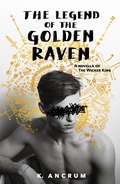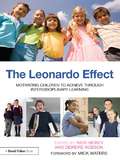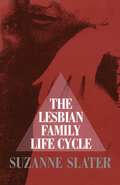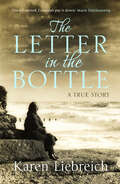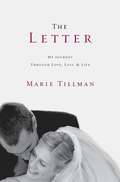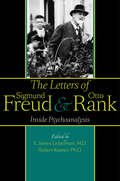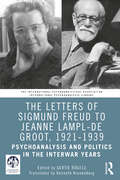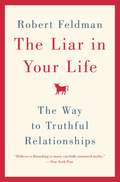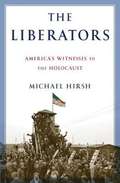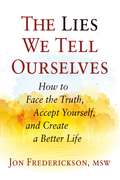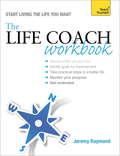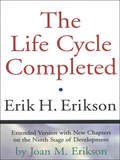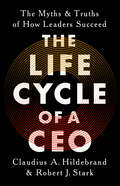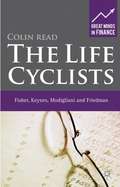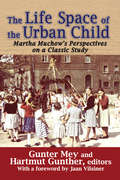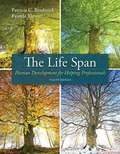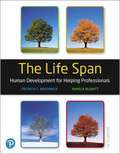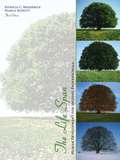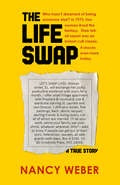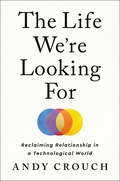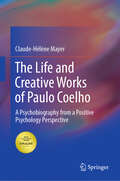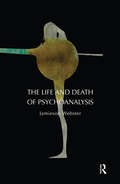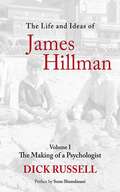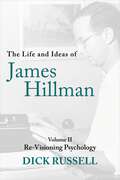- Table View
- List View
The Legend of the Golden Raven: A Novella of The Wicker King
by K. AncrumThe Legend of the Golden Raven novella, part fairy tale and part gritty reality, follows a boy as he descends into madness. August and Jack weren’t meant to be friends. One is a misfit with a pyro streak and the other a golden boy on the rugby team. But as their relationship intensifies, Jack slowly begins to lose his mind—taking readers on an intimate journey into the fantasy kingdom creeping into the edges of his world.As the novella moves back and forth between a medieval legend and our own, contemporary world, nothing is as it seems. The boys alienate everyone around them as they struggle with their sanity and as Jack’s quest to fulfill a dark prophecy begins to consume them both . . .
The Leonardo Effect: Motivating Children To Achieve Through Interdisciplinary Learning
by Ivor Hickey Deirdre Robson'Children learned more in a week than they normally would in a term' Fiona Loudon, Head Teacher 'The pupils were captivated by the excitement, a captivation that in turn led to an increase in literacy levels, self-motivation and cooperative learning' Emer Vance, Teacher and Scott Vance, Head Teacher The Leonardo Effect ties together the whole prima
The Lesbian Family Life Cycle
by Suzanne SlaterUntil now, lesbian families have had little help in identifying the stages of their couple relationships or recognizing the often stressful periods of relational transition. In this first-of-its-kind book, psychotherapist Suzanne Slater describes the joys and stresses common to lesbian families and provides a five-stage model of the development of lesbian couple relationships, from formation through old age and death. Drawing on sixteen years of clinical experience and research, Slater shows that lesbian families with and without children have created their own richly diverse family patterns, extending both the parameters of coupled life and the very definition of what constitutes "family. " She describes the tasks, challenges, and accomplishments particular to each stage of the family life cycle, and helps couples distinguish between normal developmental stresses and the unique difficulties of particular couples. She considers in detail lesbian couples' interaction with their original families, with the straight world, and with the lesbian communities of which they are a part. Through a range of examples and cases, Slater addresses how lesbian families are affected by their position in a homophobic culture and details the unique coping mechanisms that different lesbian couples have created. Most important, she emphasizes the sources of fulfillment common to many lesbian families. In addition to educating lesbian couples and those close to them, this book will prepare psychotherapists to design more effective and informed therapeutic strategies. Instead of relying on theory based on heterosexual experience, clinicians can now base their interventions on what is normal for lesbian family life. The Lesbian Family Life Cycle will be invaluable reading for lesbian family members, their friends and relatives, and clinicians in a variety of helping professions.
The Letter in the Bottle
by Karen LiebreichOn a winter's day in 2002, a bottle shaped like a tear washed up on the Kent coast. It contained a letter written in French, a lock of hair, and a mystery. Only one thing could be known for certain—that the writer of the letter was a mother, grieving for her lost child, Maurice. Moved by the woman's heartache, Karen Liebreich sets out on an epic journey to piece together the mother's story. Her book is the amazing true story of one woman's search for another, and a poignant reflection on love, loss, and motherhood. In this revised edition Liebreich concludes her epic quest, finally meeting the woman who sent the bottle years before, and coming to understand the loss that was at the heart of one mother's impulse to communicate with the unknown.
The Letter: My Journey Through Love, Loss, and Life
by Marie TillmanIn 2003, Pat Tillman, serving in the US Army, hastily wrote a "just in case" letter to his wife, Marie. When he returned on leave before his departure to Afghanistan, he placed the letter on top of their bedroom dresser. For months it sat there, sealed and ever-present, like a black hole through which Marie knew her stable life would be pulled if she ever had reason to open it. Then, in April 2004, Marie's worst nightmare came true. In the days following his death, it was Pat's letter that kept her going and, more than that, it was his words that would help her learn to navigate a world she could no longer share with her husband. In THE LETTER, Marie's talks for the first time about her journey to remake her life after Pat's death. In it, she recalls meeting and falling in love with Pat when they were kids, his harrowing decision to join the army after 9/11, and the devastating day when she learned he'd been killed. She describes how she withdrew from the public spotlight to grieve, learning along the way the value of solitude, self-awareness and integrity in the healing process. And, finally, Marie recounts her work to rebuild her life, including founding The Pat Tillman Foundation, an organization established to carry forth Pat's legacy of leadership, and her decision to step back into the public eye in order to inspire people to live with meaning and purpose.Filled with the lessons Marie learned and the wisdom she gained since Pat's death, THE LETTER is both a heartrending love story and an inspiring tale for anyone, young or old, whose life has taken an unexpected hard turn -- and who struggles to get back on the right path.
The Letters of Sigmund Freud and Otto Rank: Inside Psychoanalysis
by E. James Lieberman Gregory C. RichterSigmund Freud’s relationship with Otto Rank was the most constant, close, and significant of his professional life. Freud considered Rank to be the most brilliant of his disciples. The two collaborated on psychoanalytic writing, practice, and politics; Rank was the managing director of Freud’s publishing house; and after several years helping Freud update his masterpiece, The Interpretation of Dreams, Rank contributed two chapters. His was the only other name ever to be listed on the title page. This complete collection of the known correspondence between the two brings to life their twenty-year collaboration and their painful break.The 250 letters compiled by E. James Lieberman and Robert Kramer humanize and dramatize psychoanalytic thinking, practice, and organization from 1906 through 1925. The letters concern not just the work and trenchant contemporaneous observations of Freud and Rank but also their friendships, supporters, rivals, families, travels, and other personal and professional matters. Most interestingly, the letters trace Rank’s growing independence, the father-son schism over Rank’s "anti-Oedipal" heresy, his surprising reconciliation with Freud, and the moment when they parted ways permanently. A candid picture of how the pioneers of modern psychotherapy behaved with their patients, colleagues, and families—and each other—the correspondence between Freud and Rank demonstrates how psychoanalysis developed in relation to early twentieth-century science, art, philosophy, and politics.A rich primary source on psychiatry, history, and culture, The Letters of Sigmund Freud and Otto Rank is a cogent and powerful narrative of early psychoanalysis and its two most important personalities.
The Letters of Sigmund Freud to Jeanne Lampl-de Groot, 1921-1939: Psychoanalysis and Politics in the Interwar Years
by Gertie BögelsFreud wrote 76 letters to the Dutch psychoanalyst Jeanne Lampl-de Groot between 1921 and 1939. These letters are personable, lively, and compassionate and convey his respect and caring for Jeanne, who was his patient, pupil, and eventually his esteemed professional colleague. The letters are sociohistorical documents that contain Freud’s thoughts about pertinent issues in psychoanalysis and the interwar sociopolitical situation in Vienna and Germany. Jeanne Lampl-de Groot was an internationally known psychoanalyst who published extensively on psychoanalytic theory and practice. She regularly wrote long letters to Freud when residing outside of Vienna, seeking his advice on personal and professional matters and discussing with him her evolving ideas about psychoanalysis, including her disagreement with Freud about female sexual development. It is unfortunate that Jeanne had her letters to Freud destroyed because it sometimes makes Freud’s somewhat elliptical responses difficult to place in context. For example, it is quite probable that she wrote detailed descriptions of her husband’s emotional issues, which Freud then merely alluded to. Because we don’t know the specifics of what she wrote, his responses remain ambiguous, and therefore problematic to translate. Nonetheless, Freud’s responses do reveal a great deal about Jeanne and her passion for psychoanalysis. The book also includes several of her letters to her parents, which allows the reader to get to know Jeanne’s intelligent, thoughtful voice, her thoughts about the evolving science of psychoanalysis, her experience during her psychoanalysis with Freud, and her concerns about the rise of anti-Semitism in Austria and Germany. This book introduces to its readers a very personable Freud and provides insight into his thoughts about the development of critical psychoanalytic concepts such as the death drive, masochism, lay analysis, and his changing views on the length of a psychoanalysis. We also hear about historical events in the 1920s and 1930s as we witness Freud and Lampl-de Groot move through their personal and professional lives with dignity and perseverance.
The Liar in Your Life: The Way to Truthful Relationships
by Robert FeldmanIn The Liar in Your Life,psychology professor Robert Feldman, one of the world's leading authorities on deception, draws on his immense body of knowledge to give fresh insights into how and why we lie, how our culture has become increasingly tolerant of deception, the cost it exacts on us, and what to do about it. His work is at once surprising and sobering, full of corrections for common myths and explanations of pervasive oversimplifications. Feldman examines marital infidelity, little white lies, career-driven resumé lies, and how we teach children to lie. Along the way, he reveals-despite our beliefs to the contrary- how it is nearly impossible to spot a liar (studies have shown no relationship between nervousness, lack of eye contact, or a trembling voice, and acts of deception). He also provides startling evidence of just how integral lying is to our culture; indeed, his research shows that two people, meeting for the first time, will lie to each other an average of three times in the first ten minutes of a conversation. Feldman uses this discussion of deception to explore ways we can cope with infidelity, betrayal, and mistrust, in our friends and family. He also describes the lies we tell ourselves: Sometimes, the liar in your life is the person you see in the mirror. With incisive clarity and wry wit, Feldman has written a truthful book for anyone who whose life has been touched by deception.
The Liberators: America’s Witnesses to the Holocaust
by Michael HirshAt last, the everyday fighting men who were the first Americans to know the full and horrifying truth about the Holocaust share their astonishing stories. Here we meet the brave souls who--now in their eighties and nineties--have chosen at last to share their stories.
The Lies We Tell Ourselves: How to Face the Truth, Accept Yourself, and Create a Better Life
by Jon FredericksonDo you feel stuck in your life? Do you wonder why? Does something seem wrong, but you can't put your finger on it? In The Lies We Tell Ourselves, psychotherapist Jon Frederickson reveals the ways we fool ourselves and how to get unstuck. Through dozens of stories and examples, he shows how the apparent cause of our problems is almost never the real cause. In addition, he reveals what we really fear and how to face it. In these pages you'll discover * How to identify the lies you tell yourself * How to face the truths you have avoided * Why you stay with someone who isn't good for you * How to stop saying yes when you really mean no Although we may use falsehoods to escape pain, clinging to our fantasies actually becomes the source of greater suffering. This book shows how to create a better life by letting go of our lies and facing reality. It also demonstrates that therapy is not merely a chat; it is a relationship between two people devoted to facing the deepest truths of our lives so we can be healed. "This book is a revelation--a gift to all who come across it. I can't recommend this book highly enough!" --Patricia Coughlin, PhD, author of Intensive Short-Term Dynamic Psychotherapy "I wholeheartedly recommend this book to everyone who wants to see what therapy is really about or who wants to increase the value of the psychotherapy they engage in or offer to others." --Peter Fenner, PhD, author of Radiant Mind and Natural Awakening
The Life Coach Workbook: Teach Yourself
by Jeremy RaymondAre you at a crossroads in life? Do you want to make a career change or other transformation? Would you like lasting strategies to help you set achievable goals and targets? This workbook uses a holistic and whole-life approach to life coaching along with self-assessment and interactive tasks to help you set and achieve new goals. It doesn't just tell you how to change your life; by using diagnostic tests, practical exercises, and thought challenges, it will show you how to identify the areas of your life which are making you feel less than satisfied, and achievable plans for change. The contents help you identify your own life-coaching needs, allowing you to pick a path through the book that works for you, while giving you practical support for managing change and long-term planning for a happier future.
The Life Coach Workbook: Teach Yourself
by Jeremy RaymondAre you at a crossroads in life?Do you want to make a career change or other transformation?Would you like lasting strategies to help you set achievable goals and targets?This workbook uses a holistic and whole-life approach to life coaching along with self-assessment and interactive tasks to help you set and achieve new goals. It doesn't just tell you how to change your life; by using diagnostic tests, practical exercises, and thought challenges, it will show you how to identify the areas of your life which are making you feel less than satisfied, and achievable plans for change. The contents help you identify your own life-coaching needs, allowing you to pick a path through the book that works for you, while giving you practical support for managing change and long-term planning for a happier future.
The Life Cycle Completed (Extended Version)
by Erik H. Erikson Joan M. Erikson"This book will last and last, because it contains the wisdom of two wonderfully knowing observers of our human destiny."--Robert Coles For decades Erik H. Erikson's concept of the stages of human development has deeply influenced the field of contemporary psychology. Here, with new material by Joan M. Erikson, is an expanded edition of his final work. The Life Cycle Completed eloquently closes the circle of Erikson's theories, outlining the unique rewards and challenges--for both individuals and society--of very old age.
The Life Cycle of a CEO: The Myths and Truths of How Leaders Succeed
by Claudius A Hildebrand Robert J Stark"A groundbreaking exploration of corporate leadership that challenges conventional wisdom." - Hubert Joly, former CEO of Best Buy Being appointed CEO is seen by many as the pinnacle of success in business, but it is actually the first step in a journey of evolving stages requiring ongoing personal reinvention. In an unprecedented study of the individual performance of every twenty-first-century CEO of the S&P 500, combined with over 100 in-depth interviews of CEOs and board directors, Claudius A. Hildebrand and Robert J. Stark discovered the CEO Life Cycle, a series of five stages: launch, calibration, reinvention, complacency trap, and legacy. Each presents distinctive headwinds and tailwinds that require leaders to develop the fresh skills and strategies needed to thrive. Successful CEOs are often portrayed as fully formed heroes endowed with exceptional leadership traits. Hildebrand and Stark break through the mythology to provide unique understanding, explaining how outstanding leaders surmount predictable challenges and develop the mental fortitude, emotional resilience, and self-awareness required to keep adapting. Invaluable not only for CEOs to take their game to the next level of high performance but also for executives who envision themselves in the role, The Life Cycle of a CEO provides the unvarnished truth about what it takes to be a successful CEO.
The Life Cyclists
by Colin ReadRead addresses the contributions of significant individuals to our understanding of financial decisions and markets. Great financial theorists created the basis for what we now know as personal finance and this volume describes four great minds in finance that forever established the role of the rate of return and life cycle decision-making.
The Life Space of the Urban Child: Perspectives on Martha Muchow's Classic Study
by Gunter MeyThe heart of this book is the translation of The Life Space of the Urban Child, written in 1935 by Martha and Hans Heinrich Muchow. Life Space provides a fresh look at children as actors and how they absorb their city environments. It uses an empirical base connected with theories about the worlds in which children live. The first section provides historical background on Muchow's study and the author. The second section presents the translation of the Life Space study, as well as comments from an environmental psychologist's perspective. The third section reviews the study's theoretical foundations, including the concept of "critical personalism," the perspectives of phenomenology, and the notion of Umwelt (environment). The last section addresses various lines of research developed from the Life Space study, including Muchow's work in describing children in urban environments, methodological approaches, and the significance of space in social science and educational contexts. The manner in which Martha Muchow conducted her studies is itself of note. She obtained access to the children in their environments and combined observation with cartographies and essays produced by the children. This approach was new at the time and continues to inspire researchers today. This volume is the latest work in Transaction's History and Theory of Psychology series.
The Life Span: Human Development For Helping Professionals
by Pamela Blewitt Patricia BroderickThe Life Span: Human Development for Helping Professionals, 4th edition, provides an in-depth look at the science of human development, highlighting theories and research that have useful applications for individuals working in fields such as education, counseling, and social work. The main purpose of this book is to provide the reader with information that can be translated into professional "best practice" applications. Throughout, the text reflects the contemporary view that life span development is a process deeply embedded within and inseparable from the context of family, social network, and culture. Because the book is designed for graduate students, most topics, especially those that have special relevance to helping professionals, are covered in greater depth than in a typical life span text. The expanded coverage of research in these areas will enhance students'' understanding of the scientific basis for application to practice.
The Life Span: Human Development for Helping Professionals
by Pamela Blewitt Patricia BroderickThe Life Span: Human Development for Helping Professionals, 5th Edition, provides an in-depth look at the science of human development, highlighting theories and research that have useful applications for individuals working in fields such as education, counseling, and social work. The main purpose of this book is to provide the reader with information that can be translated into professional best practice applications. Throughout, the text reflects the contemporary view that life span development is a process deeply embedded within and inseparable from the context of family, social network, and culture. Because the book is designed for graduate students, most topics, especially those that have special relevance to helping professionals, are covered in greater depth than in a typical life span text. The expanded coverage of research in these areas will enhance readers’ understanding of the scientific basis for application to practice. Because the book is designed for graduate students, most topics, especially those that have special relevance to helping professionals, are covered in greater depth than in a typical life span text. The expanded coverage of research in these areas will enhance students'' understanding of the scientific basis for application to practice. The Enhanced Pearson eText features embedded video to illustrate key concepts and pop-up assessments to help students assess their proficiency.
The Life Span: Human Development for Helping Professionals (Third Edition)
by Patricia C. Broderick Pamela BlewittBased on extensive research, the book effectively provides an array of information about principles of human development from birth to death.
The Life Swap
by Nancy WeberIn February of 1973, Nancy Weber put an ad in the Village Voice offering to trade places with another woman, a stranger, for a month. In hopes of better understanding what was fixed and final in each person--and what was invented, and therefore might be reinvented--they would use each other's names, live in each other's homes, love each other's loves, and do each other's work. After interviewing many of the fascinating women who answered the ad, Weber--single (with a longtime lover) and straight--chose a polyamorous, bisexual, married psychologist and academic, the pseudonymous Micki Wrangler. They spent five months getting ready for their adventure--cajoling their nearest and dearest into participating, exchanging thousands of details, and swapping deep secrets. But, instead of a month, their wild ride lasted only a week. Wrangler was having a rough time (and Weber too good a time, maybe) so they decided to call things off. Wanting The Life Swap to convey more than her own experience, Weber invited Wrangler and ten others to enrich the book with their uncensored reports. Publicity for the book included stints on The Tonight Show with Johnny Carson and To Tell the Truth. The book achieved a kind of cult status, in part because it's a relic of 1970s sexual openness (cruelly destroyed by HIV/AIDS) and belief in the right of self-invention. Recent critics have credited the book with inspiring life swap reality TV shows and several popular novels and films.
The Life We're Looking For: Reclaiming Relationship in a Technological World
by Andy CrouchA deeply reflective primer on creating meaningful connections, rebuilding abundant communities, and living in a way that engages our full humanity in an age of unprecedented anxiety and loneliness—from the author of The Tech-Wise Family&“Andy Crouch shows the path to reclaiming a life that restores the heart of what it means to thrive.&”—Arthur C. Brooks, #1 New York Times bestselling author of From Strength to StrengthOur greatest need is to be recognized—to be seen, loved, and embedded in rich relationships with those around us. But for the last century, we&’ve displaced that need with the ease of technology. We&’ve dreamed of mastery without relationship (what the premodern world called magic) and abundance without dependence (what Jesus called Mammon). Yet even before a pandemic disrupted that quest, we felt threatened and strangely out of place: lonely, anxious, bored amid endless options, oddly disconnected amid infinite connections.In The Life We&’re Looking For, bestselling author Andy Crouch shows how we have been seduced by a false vision of human flourishing—and how each of us can fight back. From the social innovations of the early Christian movement to the efforts of entrepreneurs working to create more humane technology, Crouch shows how we can restore true community and put people first in a world dominated by money, power, and devices.There is a way out of our impersonal world, into a world where knowing and being known are the heartbeat of our days, our households, and our economies. Where our vulnerabilities are seen not as something to be escaped but as the key to our becoming who we were made to be together. Where technology serves us rather than masters us—and helps us become more human, not less.
The Life and Creative Works of Paulo Coelho: A Psychobiography from a Positive Psychology Perspective
by Claude-Helene MayerThis book assesses the life and success of the writer Paulo Coelho, one of the most fascinating and contemporary writers in the world, through new lenses. It applies a positive psychology perspective and contributes to using innovative theories in psychobiographical studies. This study explores the development of holistic wellness (HWM) and faith development (FDT) throughout the writer's life. It presents radical changes in spirituality, self-direction, love and faith across the life span. Further, it analyses the development of Coelho’s relationship with God and the creation of meaningfulness through his belief and writing. This study contributes to a new era of psychobiographical works within the positive psychology framework.
The Life and Death of Psychoanalysis
by Jamieson WebsterFrom its peculiar birth in Freud’s self-analysis to its current state of deep crisis, psychoanalysis has always been a practice that questions its own existence. Like the patients that risk themselves in this act - it is somehow upon this threatened ground that the very life of psychoanalysis depends. Perhaps psychoanalysis must always remain in a precarious, indeed ghostly, position at the limit of life and death?
The Life and Ideas of James Hillman: The Making of a Psychologist
by Dick Russell Sonu ShamdasaniConsidered to be the world's foremost post-Jungian thinker, James Hillman is known as the founder of archetypal psychology and the author of more than twenty books, including the bestselling title The Soul's Code. In The Making of a Psychologist, we follow Hillman from his youth in the heyday of Atlantic City, through post-war Paris and Dublin, travels in Africa and Kashmir, and onward to Zurich and the Jung Institute, which appointed him its first director of studies in 1960. This first of a two-volume authorized biography is the result of hundreds of hours of interviews with Hillman and others over a seven-year period. Discover how Hillman's unique psychology was forged through his life experiences and found its basis in the imagination, aesthetics, a return to the Greek pantheon, and the importance of "soul-making," and gain a better understanding of the mind of one of the most brilliant psychologists of the twentieth century.
The Life and Ideas of James Hillman: Volume II: Re-Visioning Psychology
by Dick RussellJames Hillman, who died in 2011 at the age of eighty-five, has been described by poet Robert Bly as &“the most lively and original psychologist&” of the twentieth century. Based on author Dick Russell&’s interviews with Hillman and dozens of people who knew him, Volume Two of The Life and Ideas of James Hillman takes up Hillman&’s mid-life when he set about returning psychology to its Soul-rich roots in Greek mythology and Renaissance esotericism. From his base teaching at Zurich&’s Jung Institute, we follow Hillman&’s growing international prominence as a maverick in the field, coinciding with his relationship and eventual marriage to Patricia Berry. They would be instrumental in formulating Archetypal Psychology, along with a group of young compatriots in what became known as Spring House. The new ideas taking shape moved psychology away from the dominant scientific/medical model with its focus on treating the isolated individual, expanding into the fertile realm of culture and the imagination. Amid prodigious writings and lectures, Hillman made mythology and even alchemy relevant to our times. Delivering the prestigious Terry Lectures at Yale and being nominated for a Pulitzer Prize, Hillman returned to America after living primarily in Europe for thirty years. To the surprise of many, he settled in Dallas and helped found an Institute of Humanities and Culture while taking up how to re-imagine city planning. Equally surprising was Hillman&’s subsequent move to rural Connecticut, where he and Pat Berry resided in a nineteenth-century farmhouse. Starting in the mid-&’80s, Hillman became a pioneering teacher in the mythopoetic men&’s movement alongside Robert Bly and Michael Meade—where deep talk about fathers and sons and male-female relationships offered a new kind of group therapy, a cultural therapy. As Thomas Moore said of Hillman, he possessed a &“genius for taking any theme and shedding serious fresh light on it.&” Along the way, Hillman&’s insights came to encompass all of the arts, a &“poetic basis of mind&” that connected him to many of the most influential artists and thinkers of the modern era.
